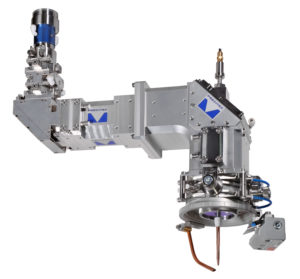Pushing wire into the future of additive manufacturing: With the CoaxPrinter, Precitec GmbH & Co. KG brings a solution for laser cladding to market, which permits a multidirectional processing of the additive material wire for the first time. The CoaxPrinter provides clear advantages to powder, in regards to, economic efficiency, cleanliness and sustainability in surface treatment, parts repair and 3D printing.
“Changes of direction of 90 degrees are almost impossible with other wire-based laser cladding solutions”, says Dr Markus Kogel-Hollacher, R&D project manager at Precitec: “The CoaxPrinter closes a technological gap, not only in case of the wire-based cladding procedure. Users achieve an unprecedented flexibility for their processing procedures.”
Coaxial feed into interaction zone

The processing head is able to feed wire coaxially into the interaction zone. The beam profile is circular and focussed directly into the interaction point between the wire and workpiece surface. Thus, the CoaxPrinter allows a shadow-free wire feeding, an omnidirectional intensity distribution, a homogenized preheating, and an energy input perfectly controlled for the process. The wire feeding itself is sensor-monitored, which is ideal for automated manufacturing.
Benefits of Wire based cladding for AM
Cladding with wire allows economical, clean and environmentally-friendly processes for 3D printing, for various surface coatings or for wear protection. High surface quality is standard producing a high density, porosity-free build with perpendicularity of all generated structures.
Furthermore, the processing procedure with wire produces no contaminations of the surrounding areas or surfaces. By using wire, users achieve an effective material utilisation of 100 percent.
Compatible with common laser sources
The CoaxPrinter processes almost every solid or flux-cored wire for welding or soldering application in standard dimensions. The processing head is also compatible with common multi-kw fibre coupled diode lasers with a core diameter of the fibre of 0.6 millimetres and a power of 6 kilowatts. Standard industrial robots or portal systems serve as manipulator.
“The possibility to work entirely in 3D without material loss opens new areas for laser cladding”, says Dr Kogel-Hollacher looking ahead. In cooperation with the market, Precitec pursues the goal to expand the areas of application for the new wire-based laser cladding.



